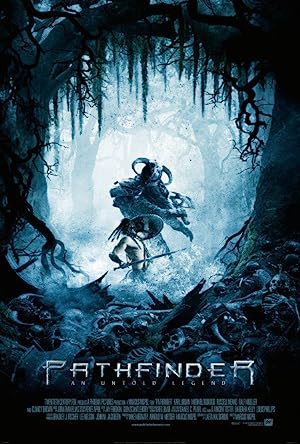Pathfinder is about the only survivor, a child, of a Viking ship that arrives at our shores when Native Americans were the only people living on the North American continent. He gets adopted, becomes Karl Urban, whom I’ve loved since Xena: The Warrior Princess, and fights the Vikings when they return because they are more technologically advanced-swords beat wood.
I’m not sure what I expected from Pathfinder—possibly an unofficial sequel to Valhalla Rising, but I put it in my queue long before I saw the latter. Maybe I was attracted to the idea of Vikings versus Native Americans, and Native Americans winning for even a brief time. When I began watching the movie, I groaned because it was obvious from the description that Pathfinder had the potential to only be a one hundred seven minute white savior trope, which it isn’t entirely because Urban’s character never becomes the best Native American like Avatar. His advantage is that he speaks the Vikings’ language and is familiar with their weapons and strategies.
Pathfinder is disappointing because it has a lot of unexpected twists that showed me how this movie was not just another empty action movie wanting to geek out on an explosive clash of cultures in battle, but actually gave a lot of thought to how you could plausibly beat a technologically superior invading force using guerrilla tactics and reverse psychology. Maybe the best parts of this movie were lifted entirely from the original Norwegian Oscar award winning film with the same title when translated, Ofelas or Veiviseren, which sadly is unavailable for home viewing so I’ll never know. The fight scenes are too dark to enjoy, and there is very little that distinguishes one Viking from another. What is the point of snagging Clancy Brown if he is barely recognizable under all that hair and armor. Pathfinder has no problem embracing clichés. If there is a cliff, someone is falling off of it.
Pathfinder shows that same quality in its treatment of women characters: embrace the cliché while simultaneously completely subverting it. There aren’t that many women characters—just enough that I can’t deride it by saying that it sets up a Smurfette situation, but not by much. Women scream a lot and loudly in situations where stealth may better insure their safety. On one hand, the women clearly have an important voice in this interpretation of Native American society and are even skilled leaders, but on the other, their dominant role is as a love interest. Poor Moon Bloodgood. Whenever I see her, she has to deal with invading aliens from this movie to the TV series Falling Skies.
The following is pure conjecture, but I suspect that no historians were consulted in the making of Pathfinder, or they were consulted and dismissed in exchange for something cooler. The Vikings are pure creatures from our imagination-enormous, loud killing machines. They bear more of a resemblance to orcs in Lord of the Rings than people. They are more like demonic Nazis (too repetitive?) pursuing ethnic cleansing than wanting goods and land. While it is a nice change to have the invaders depicted as the bad guys, and the filmmaker relating to the Native Americans as opposed to the reverse, it doesn’t mean that they should be indistinguishable in personality. They are just screaming hordes bent on killing and think that Native Americans are savages that need to be wiped out so they can occupy the land. I think that the movie is thinking of subsequent invaders. I have zero historical knowledge of Vikings, but my impression was that they were equal opportunity invaders who had no particular grudge against one group except with respect to religious differences, i.e. pagan versus Christian, because of their own experience with invading. Because I did not find the enemy interesting, I was not invested in the overall plot.
Maybe I’m the problem. I was bothered by the fact that I was not entirely sure of the definition of Pathfinder. It was a character, but was it also a title and/or a noun? Where does it fall in the hierarchy of Native American society? There was potential for more tension when the braves don’t take Karl’s advice and decide to fight, but they are dispatched rather quickly instead of teasing out the main character’s worst nightmare. Even though the film is cheesy to sync moments of identity resolution with pivotal turning points in the battle, I enjoyed the cheese while rolling my eyes. The most interesting person is Pathfinder, the chief from the tribe next door with the hot daughter. Perhaps the titular character should be the main character instead of a supporting character.
Pathfinder’s similarities to later movies such as The Revenant’s obstacles and Black Panther’s final post credits scene was unexpected and hopefully a coincidental. Anything is possible, but I find it unlikely that Ryan Coogler or Alejandro G. Inarritu ever saw this film. I think that the better question is what movie(s) did Marcus Nispel, Coogler and Inarritu watch that inspired these narrative beats and visual similarities. They could be common tropes, but I am unfamiliar with them.
Pathfinder’s story is just interesting enough that you can’t dismiss it as empty action that should be forgotten, but the action isn’t visually clear enough to just appreciate the spectacle. In the end, it is too lukewarm to recommend it to any but the most stalwart fans of the cast. It is a movie torn by its baser instincts and its innate talent that it creates an unsatisfying mix that will please no one.
Stay In The Know
Join my mailing list to get updates about recent reviews, upcoming speaking engagements, and film news.





